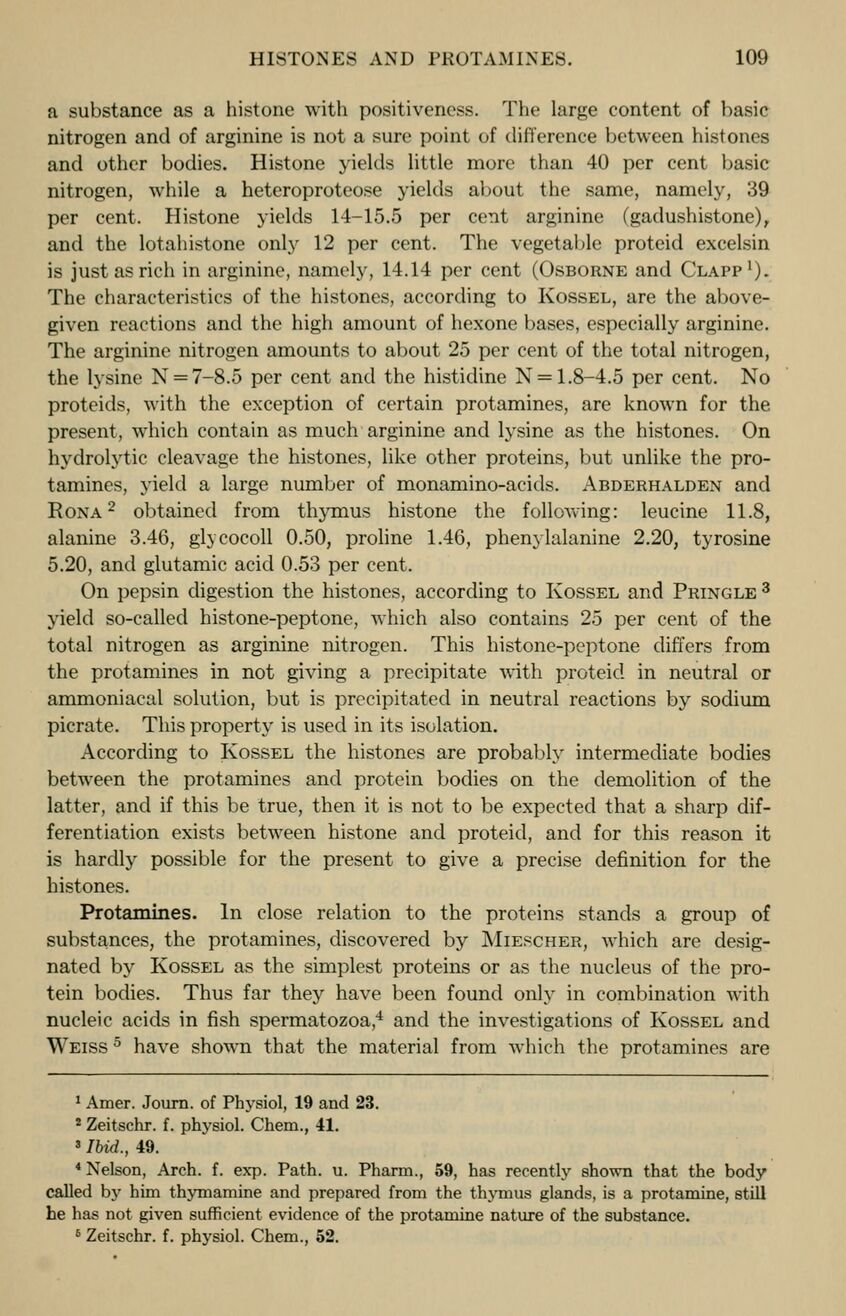
Full resolution (JPEG) - On this page / på denna sida - II. The Protein Substances - I. Simple Proteins - A. True Albuminous Bodies - Synopsis of the Most Important Properties of the Different Groups of Albuminous Bodies

<< prev. page << föreg. sida << >> nästa sida >> next page >>
Below is the raw OCR text
from the above scanned image.
Do you see an error? Proofread the page now!
Här nedan syns maskintolkade texten från faksimilbilden ovan.
Ser du något fel? Korrekturläs sidan nu!
This page has never been proofread. / Denna sida har aldrig korrekturlästs.
HISTONES AND PROTAMINES. 109
a substance as a histone with positivencss. The large content of basic
nitrogen and of arginine is not a sure point of difference between hist ones
and other bodies. Histone yields little more than 40 per cent basic
nitrogen, while a heteroproteose yields about the same, namely, 39
per cent. Histone yields 14-15.5 per cent arginine (gadushistone),
and the lotahistone only 12 per cent. The vegetable proteid excelsin
is just as rich in arginine, namely, 14.14 per cent (Osborne and Clapp 1
).
The characteristics of the histones, according to Kossel, are the above-
given reactions and the high amount of hexone bases, especially arginine.
The arginine nitrogen amounts to about 25 per cent of the total nitrogen,
the lysine N = 7-8.5 per cent and the histidine N = 1.8-4.5 per cent. No
proteids, with the exception of certain protamines, are known for the.
present, which contain as much arginine and lysine as the histones. On
hydrolytic cleavage the histones, like other proteins, but unlike the pro-
tamines, yield a large number of monamino-acids. Abderhalden and
Rona 2
obtained from thymus histone the following: leucine 11.8,
alanine 3.46, glycocoll 0.50, proline 1.46, phenylalanine 2.20, tyrosine
5.20, and glutamic acid 0.53 per cent.
On pepsin digestion the histones, according to Kossel and Pringle 3
yield so-called histone-peptone, which also contains 25 per cent of the
total nitrogen as arginine nitrogen. This histone-peptone differs from
the protamines in not giving a precipitate with proteid in neutral or
ammoniacal solution, but is precipitated in neutral reactions by sodium
picrate. This property is used in its isolation.
According to Kossel the histones are probably intermediate bodies
between the protamines and protein bodies on the demolition of the
latter, and if this be true, then it is not to be expected that a sharp dif-
ferentiation exists between histone and proteid, and for this reason it
is hardly possible for the present to give a precise definition for the
histones.
Protamines. In close relation to the proteins stands a group of
substances, the protamines, discovered by Miescher, which are desig-
nated by Kossel as the simplest proteins or as the nucleus of the pro-
tein bodies. Thus far they have been found only in combination with
nucleic acids in fish spermatozoa,4
and the investigations of Kossel and
Weiss 5
have shown that the material from which the protamines are
1
Amer. Journ. of Physiol, 19 and 23.
2
Zeitschr. f. physiol. Chem., 41.
3
Ibid., 49.
4
Nelson, Arch. f. exp. Path. u. Pharm., 59, has recently shown that the body
called by him thymamine and prepared from the thymus glands, is a protamine, still
he has not given sufficient evidence of the protamine nature of the substance.
6
Zeitschr. f. physiol. Chem., 52.
<< prev. page << föreg. sida << >> nästa sida >> next page >>